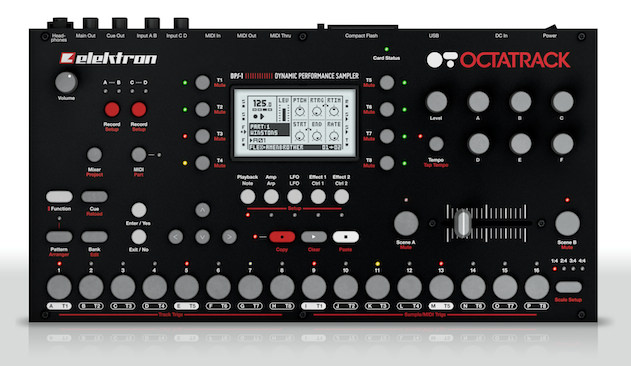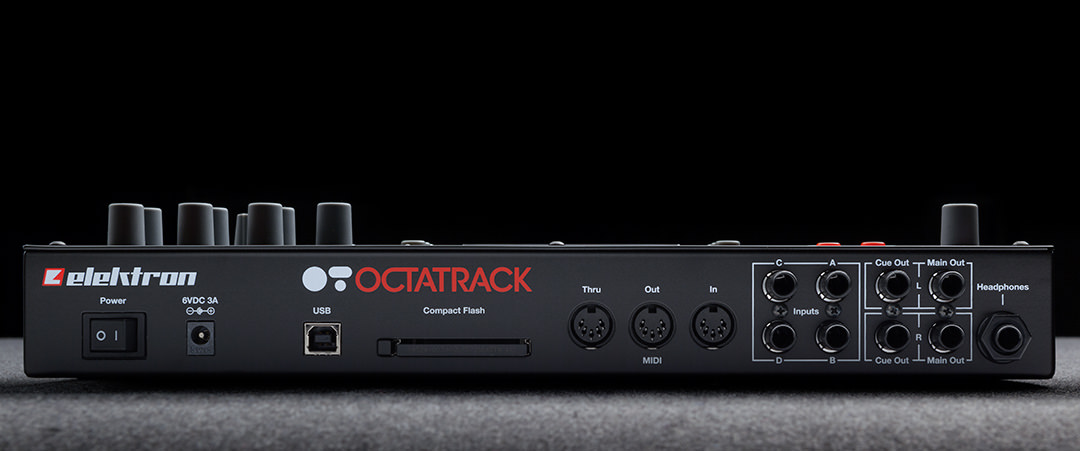We put Elektron’s revolutionary sampling workstation to the test.

Let’s be honest here: most of us thought hardware samplers were a thing of the past. Aside from a few die-hard MPC devotees and the odd masochist still persevering with an Akai S series, most of us abandoned hardware sampling long ago in favour of the convenience, efficiency and power of software alternatives – whether that be Kontakt, EXS-24 or any number of sampler plugins, or simply dragging and dropping loops and one-shots directly onto our DAW’s timeline.
The prevalence of software samplers has had serious knock-on effects on the way the majority of us make music. We take time stretching, beat slicing and looping for granted, without any of the fuss associated with hardware. We’re much more likely to buy samples rather than create our own from scratch. Electron’s Octatrack DPS-1 aims to revolutionise the way we approach sampling and single-handedly revitalise the hardware sampler market.
DPS?
The Octatrack DPS-1 is a sampling workstation with a built-in sequencer and effects (a ‘dynamic performance sampler’ in Elektron’s words), but the overall concept is quite different to what you might expect from obvious alternatives like MPCs.
The front panel of this solidly built unit is dominated by the LCD screen, which is relatively small but with a high enough resolution to offer a clear overview of all the relevant parameters for any given function. The Octatrack is based around x0x/Electribe-style step sequencing rather than the sample pads and real-time MIDI recording found on MPCs, Roland SPs and the like.
The sampling and sequencing hierarchy takes a little getting used to. At the highest level, you can create sets, which contain multiple projects and a shared audio pool. Each project can contain up to 16 banks of 16 patterns and eight arrangements. It’s a large, powerful and flexible environment in which to work, but the use of a CompactFlash card slot for sample storage and the speed of the Octatrack’s OS mean that it doesn’t feel laborious or restrictive to work with large projects as it can with many other hardware samplers. The inclusion of a USB file transfer option makes integration with a computer a little easier, although the Octatrack’s USB features are limited – you won’t find a software editor here, just the ability to drag and drop audio files into sets on the CF card.
Machines
 The basic starting points of each audio and MIDI track are the subtly different modes on offer. In keeping with Elektron tradition, these are known as ‘machines’. The machines themselves are, in fact, one of the most interesting aspects of the Octatrack’s sound engine, each offering a slightly different set of features, strengths and weaknesses.
The basic starting points of each audio and MIDI track are the subtly different modes on offer. In keeping with Elektron tradition, these are known as ‘machines’. The machines themselves are, in fact, one of the most interesting aspects of the Octatrack’s sound engine, each offering a slightly different set of features, strengths and weaknesses.
Static machines stream samples directly from the CF card, which means potential sample length is extremely long, since the maximum sample size is a hefty 2GB (that approach could potentially be useful for DJing or playing backing tracks for a live performance – athough we can’t help but feel that would be missing the point of the Octatrack slightly).
Flex machines are closest to what you might expect in software like Ableton Live, loading samples into RAM and allowing powerful real-time manipulation of sounds, from pitch shifting to slicing to time stretching.
Thru Machines and Neighbor machines are used to exploit the Octatrack’s built-in effects. The former allow external audio to be processed in real-time, while the latter picks up the audio output of the previous track in order to allow longer effect chains to be created (each track can hold two effects).
The Pickup machines introduced in OS 1.2 function as loopers, allowing looped samples to be built up in real time and overdubbed.

10.13 AM
I had this for about 6 months and absolutely hated it, the interface its terribly unintuitive and over complex, samplign is a chore and the way samples map to patterns is non standard for elektron machines. In the end I sold mine and used the money to help pay for a DSI Tempest drum machine.
For far less money you can get a brand new 4th gen iPad with 128gb of memory and a copy of the amazing “samplr” app which is so intuitive it truly is the best sampling experience Ive ever had on any device.
02.50 PM
Aiki, I too felt like you did when I got my Octatrack… I felt like I would never get anything done and it felt very complicated to use, however after putting 40 hours on it I started feeling more comfortable with it. You just have to give it time, with great power comes great responsibility.
I always knew this machine would give me sonic leverage, that is why I decided to give it time, because quite frankly it has so much power within that it takes a long time to master. All that said, I still don’t know how to use 50% of the features, just give me 1 more year with it and I will be a master of the Octatrack, or at least I hope so.
How’s your Tempest experience? I’ve heard mixed reviews.
08.18 AM
The Tempest is the single best bit of hardware I’ve ever owned (and Ive owned a lot), The sound may not be for everyone (definitely not a “pre-sets” or “sound a like machine”) but personally love it. Also the real time sound manipulation on this box is INCREDIBLE. I love it.
02.29 PM
@ Aiki
m8, i see you all over teh internets – youtube, forums, now here – bashing the elektron gear. are you paid to do that?
02.00 PM
Akai needs something intuitive, like Garage Band. He’s into iPads and apps, because Octatrack is just beyond him. That’s great. Nice review, btw.
08.05 PM
Well, i think Tempest is less intuitive than Octatrack. I have the Tempest since an year and I don’t feel very confortabme with. Unless it’s great to play live but very hard to menage its sound with a menue that is a real pain. It’s also another type of gear. I just try the Octatrack in a shop and i was blowed away by its sound! i will buy that ant honestely i thing is far better than a software. I’m talking about having a tool to perform live : every movement has its sence and you can put the energy you want once you know it. I just try that for half an hour in a shop and i get so fast familiar with it. The Tempest tokes me 2 entire days to start making something and my girlfriend hated me for that.
01.18 PM
I have a elektron machinedrum from 2008. when I first tryed the Octatrack at my local shop I find it very easy to use.
09.27 PM
I also owned an Octatrack for about a year. The learning curve was vertical and I never got to grips with it, I switched back to an MPC in the end and enjoyed it much more. There is undoubted power in the Elektron gear but it all has avery specific workflow which might not be for everyone. The one thing that is most annoying about the octatrack though is the stereo out rather than individual outs, I have no idea what they were thinking there.